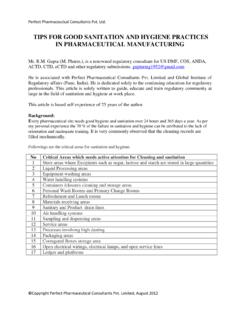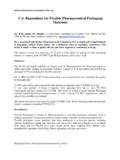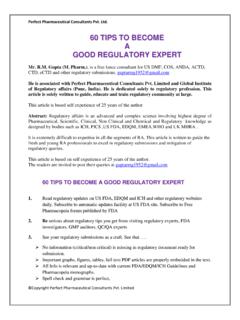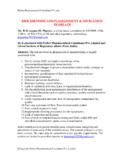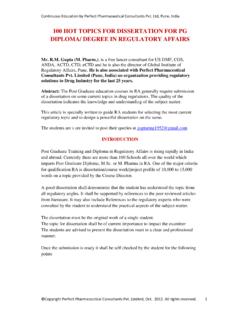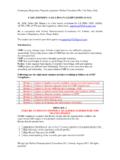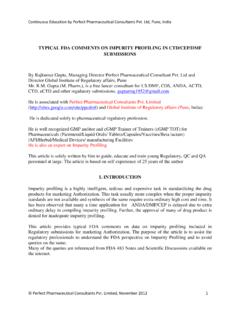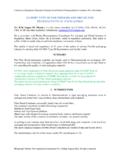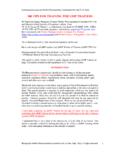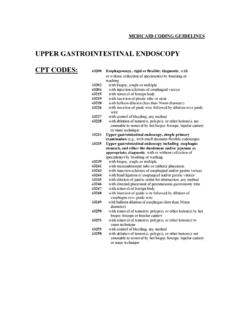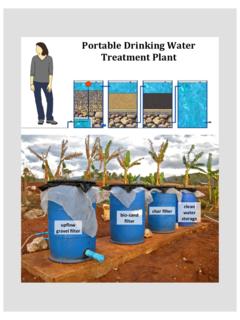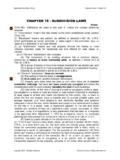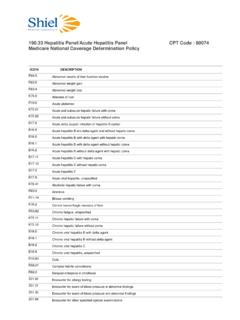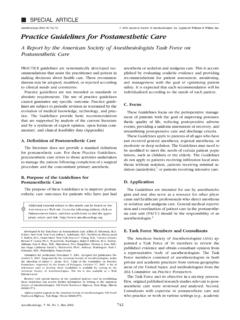Transcription of TOP 50 DEFICIENCIES IN CTD DOSSIERS - …
1 TOP 50 DEFICIENCIES IN CTD DOSSIERS . Mr. Gupta (M. Pharm.), is a free lancer consultant for US DMF, COS, ANDA, ACTD, CTD, eCTD and other regulatory submissions. He is associated with Perfect Pharmaceutical Consultants Pvt. Limited and Global Institute of Regulatory affairs (Pune, India). Abstract: The DEFICIENCIES in CTD submission delay the registration process. Proper regulatory environment is essential to draft CTD and other regulatory submissions. Followings are most common DEFICIENCIES observed in CTD submissions to regulatory authorities.
2 This article is based on the personal experience of the author and will be beneficial for regulatory professionals . The readers are invited to post their queries at Top DEFICIENCIES observed in CTD DOSSIERS : 1. Supportive clinical and nonclinical full text articles are not provided in the dossier (Module IV and V). 2. Literature cited in Module IV and Module V is not properly summarized in Module II. Further the clinical and nonclinical summary does not match with the full text articles provided in Module IV and V. 3. Photocopies and/or full reference particulars of literature used in Module IV and Module V are illegible and cannot be read properly.
3 4. Files are poorly bound. 5. Table of contents is incomplete. 6. No version number and no date assigned to the dossier. 7. Pagination of the submission is faulty. 8. Full description of the reactions/steps used in the API synthesis is not presented. The drug substance purification is not at all provided. The Specifications of starting materials, reagents, catalysts, solvents and intermediates used in the process are not described in full. The mass balance in the exhibited reactions scheme is incorrect. 9. Though Toluene is used as solvent in the synthesis but the same has not been tested for the presence of residual benzene.
4 10. The physical constants such as solubility in water, buffers at different pH values &. organic solvents are not described. 11. Existence/absence of polymorphism and chirality is not discussed. 12. Hygroscopicity, particle size distribution, flowability, granularity etc. not discussed in detail. 13. API specifications lack attributes additional to compendia monograph, residual solvents, particle size distribution, chirality, polymorphism, crystal structure 14. COA for secondary/working standards not provided. 15. COA and other QC documents are not signed dated and certified by QA.
5 16. The forced degradation data is provided from literature. The actual studies are not provided. 17. The stability indicating method has not been used for stability studies. 18. Pharmaceutical development reports are incomplelete. 19. Some of the Excipients actually used in the drug formulations are not included in batch formula. 20. The quantity and standard for some of the Excipients not indicated in the unit and batch formula .Commercial colorant mixtures are used for tablet coating. The composition and test methods for the same are not detailed.
6 21. Microbial limit is not included in FP specifications. 22. Some of the documents such as stability studies report, method validation, and process validation are not in English. 23. TSE/BSE declaration is not provided for the sensitive Excipients and drugs ( Mg- stearate ). 24. Process validation report on first 3 commercial batches is not provided. 25. Release/stability specifications are not provided. 26. Real-time stability studies carried out without considering zone conditions. 27. The spectral data such as IR, NMR,Elemental Analysis, X Ray Diffraction as a means for evidence of chemical structure is missing.
7 28. Isomerism,Stereochemistry , Poly morphism studies and discussion on the API used in dosage form is lacking. 29. API is sourced from two different vendors. However, Name and compelete contact details of each API-manufacturer is not provided Further, route of manufacturing, reaction scheme, brief process and impurity profiling of the product from each source is not provided. 30. Methods used to assess impurities are not qualified. Potential impurities are not discussed. Though inorganic toxic substances ( cyanide/thiocyanate) and hazardous reagents ( triethylamine/ alkyl halides) are used in the process but residual limits are not provided.
8 Specifications of raw materials and intermediates used in the synthesis are not provided. 31. TSE/BSE aspects of raw materials are totally ignored. 32. Reference standards/materials are not well characterized. 33. The quality of the APIs meet only the requirements of specific monographs but does not meet to specifications described in the general monographs of a pharmacopoeia 34. The specifications for your in-house product are not clear and complete. The test for identity and impurities are not described at all. The assay procedure is nonspecific .
9 We need duly validated HPLC /GC based specific assay method. 35. The unknown impurities present in the drug substance are more than ICH limits. 36. The drug is known to be a polymorphic in nature but the same is not discussed in the presentation. 37. Residual solvent levels are exceeding Pharmacopeia limits. 38. Chirality and polymorphism is not addressed adequately. 39. Justification for the use of Excipients which may carry reactive Impurities such as Hydrogen peroxide (other oxidized species), formaldehyde and Formic Acid is not provided 40.
10 Justification for use of highly hydrates form of API used in the product is not provided? 41. The moisture permeation data for the proposed blister pack not provided. 42. The extractable and leachable study for the proposed stoppers and plastic containers used for final packaging of the drug product is not provided. 43. ICH Q3C (impurities in residual solvents) and USP <467> are not adequately considered for controlling solvent residues in the final product. 44. The specifications for container closure system are inadequate. The type of the polymer used for immediate container of the API product need to be identified and characterized as per specifications provided in General Monographs in Pharmacopeia.
